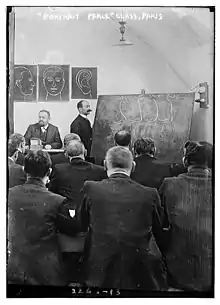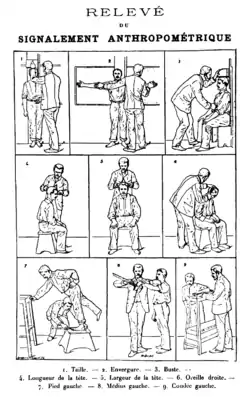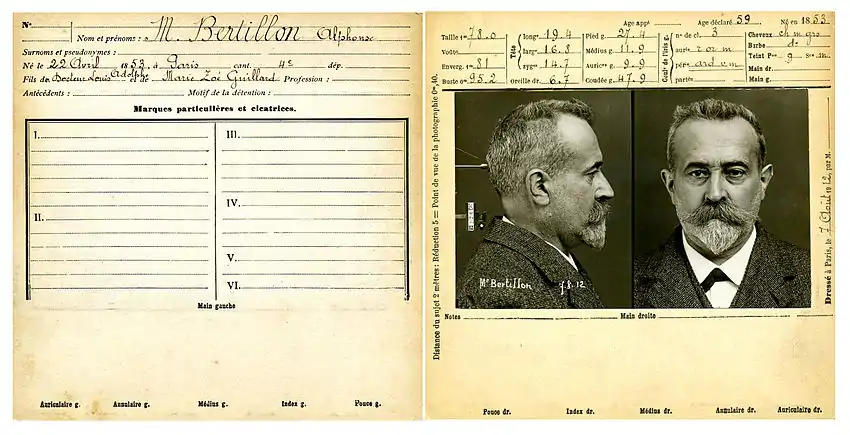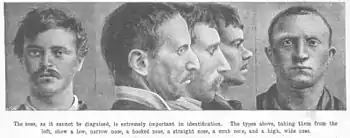Alphonse Bertillon
Alphonse Bertillon (French: [bɛʁtijɔ̃]; 22 April 1853 – 13 February 1914) was a French police officer and biometrics researcher who applied the anthropological technique of anthropometry to law enforcement creating an identification system based on physical measurements. Anthropometry was the first scientific system used by police to identify criminals. Before that time, criminals could only be identified by name or photograph. The method was eventually supplanted by fingerprinting.[1]
Alphonse Bertillon | |
|---|---|
Mugshot of Bertillon (self-portrait) | |
| Born | 22 April 1853 |
| Died | 13 February 1914 (aged 60) |
| Occupation | law enforcement officer and biometrics researcher |
| Parent(s) |
|


He is also the inventor of the mug shot. Photographing of criminals began in the 1840s only a few years after the invention of photography, but it was not until 1888 that Bertillon standardized the process.
Biography
Bertillon was born in Paris.[2] He was a son of statistician Louis-Adolphe Bertillon and younger brother of the statistician and demographer Jacques Bertillon.
After being expelled from the Imperial Lycée of Versailles, Bertillon drifted through a number of jobs in England and France, before being conscripted into the French army in 1875. Several years later, he was discharged from the army with no real higher education, so his father arranged for his employment in a low-level clerical job at the Prefecture of Police in Paris. Thus, Bertillon began his police career on 15 March 1879 as a department copyist.
Being an orderly man, he was dissatisfied with the ad hoc methods used to identify the increasing number of captured criminals who had been arrested before. This, together with the steadily rising recidivism rate in France since 1870,[3] motivated his invention of anthropometrics. His road to fame was a protracted and hard one, as he was forced to do his measurements in his spare time. He used the famous La Santé Prison in Paris for his activities, facing jeers from the prison inmates as well as police officers.

Bertillon also created many other forensics techniques, including the use of galvanoplastic compounds to preserve footprints, ballistics, and the dynamometer, used to determine the degree of force used in breaking and entering.
The nearly 100-year-old standard of comparing 16 ridge characteristics to identify latent prints at crime scenes against criminal records of fingerprint impressions was based on claims in a 1912 paper Bertillon published in France.[4]
Bertillon died 13 February 1914 in Paris.
Bertillon and the Dreyfus affair
Bertillon was a witness for the prosecution in the Dreyfus affair in 1894 and again in 1899. He testified as a handwriting expert and claimed that Alfred Dreyfus had written the incriminating document (known as the "bordereau"). However, he was not a handwriting expert, and his convoluted and flawed evidence was a significant contributing factor to one of the most infamous miscarriages of justice — the condemnation of the innocent Dreyfus to life imprisonment on Devil's Island.
Using a complex system of measurements, he attempted to prove that Dreyfus had disguised his handwriting by imitating his own handwriting as if someone else was doing so, so that if anyone thought the bordereau was in Dreyfus's hand, he would be able to say that someone else had forged his writing. Both courts martial evidently accepted this, and Dreyfus was convicted. The verdict of the second court martial caused a huge scandal, and it was eventually overturned.
Bertillon was by many accounts regarded as extremely eccentric. According to Maurice Paléologue, who observed him at the second court-martial, Bertillon was "certainly not in full possession of his faculties". Paléologue goes on to describe Bertillon's argument as "... a long tissue of absurdities", and writes of "... his moonstruck eyes, his sepulchral voice, the saturnine magnetism" that made him feel that he was "... in the presence of a necromancer".[5]
Bertillon claimed that his graphological system was based on mathematical probability calculus. A later analysis undertaken in 1904 by three renowned mathematicians, Henri Poincaré, Jean Gaston Darboux, and Paul Émile Appell, concluded that Bertillon's system was devoid of any scientific value and that he had failed both to apply the method and to present his data properly.[6] With this key evidence against Dreyfus debunked, he was finally acquitted in 1906.
Bertillon system
The specific anthropological technique practiced by Bertillon is often called the Bertillon system. This system consisted of five initial measurements — head length, head breadth, length of middle finger, length of the left foot, and length of the cubit.[7] Along with these measurements, Bertillon used photography, now known as a mugshot, to complete this system of record. These methods of identification were combined into a system for law enforcement officials to access information and images quickly.
Although the system was based in scientific measures, it was known to have its flaws. For example, it may not have been able to accurately apply to children or women, as it was mostly designed for men who had reached full physical maturity and had short hair.[8]
Alley workers in Minneapolis
In the late 19th and 20th centuries black women who were working as sex workers in Minneapolis, Minnesota became known as "alley workers". The Minneapolis Police Department followed the Bertillon system as a means to identify and document the crimes of these alley workers. The system soon became used as a tool to police and categorize these women.
In order to bypass the system many black women would use aliases instead of their real names in order to obtain agency over their criminalization. The most common name that was used as an alias was "Mamie", which was also the alias used by Mamie Knight, who was the only surviving mugshot of an alley worker during the department's period of using the Bertillon system. Her mugshot is currently located in the St. Paul police department archives.[9]
In popular culture

Bertillon is referenced in the Sherlock Holmes story The Hound of the Baskervilles, in which one of Holmes' clients refers to Holmes as the "second highest expert in Europe" after Bertillon. Also, in The Naval Treaty, speaking of the Bertillon system of measurements, "[Holmes] ... expressed his enthusiastic admiration of the French savant."
In the Arsène Lupin story The Escape of Arsène Lupin by Maurice Leblanc, Lupin escapes by exploiting the same flaws in anthropometry that led to its eventual disuse.
In Surfeit of Lampreys by Ngaio Marsh Chief Inspector Roderick Alleyn touches on the system in Chapter 14, Part 1.
Bertillon is also referenced in the Caleb Carr novel The Alienist. The Isaacson brothers, who are detectives, mention that they are trained in the Bertillon system.
Bertillon Measurements are also mentioned in Sax Rohmer's Fu Manchu-inspired The Emperor of America (Cassel, 1929, p. 61), the Ross MacDonald novels The Drowning Pool and Blue City (p. 30), Yves Fey's mystery Floats the Dark Shadow, and Agatha Christie's mystery The Secret of Chimneys (1925, chapter 27).
Bertillonage is mentioned in Chapter 4 and in an appendix of the mystery novel, The Assassin in the Marais, by Claude Izner.
Bertillon appears in Eric Zencey's novel Panama.
Bertillon is referenced in the 1965 short story, "Repent, Harlequin!" Said the Ticktockman, by Harlan Ellison.
Bertillon is the main character of the third episode of Czech television series The Adventures of Criminology called "Bertillonage".
Bertillon is also mentioned in the second episode of the seventh season of FX television series Archer.

Bertillon was also referenced in the American television series, Elementary (a modern take on Sherlock Holmes), season 2, episode 17 (Ears To You).
Bertillon is lampooned in The Dreyfus Case: IV, by Finley Peter Dunne ("Mr. Dooley"), reprinted in Mr. Dooley in the Hearts of His Countrymen (Robert Howard Russell, pub., 1899), pp. 268, ff.
Bertillon is mentioned by Hercule Poirot in 'The Murder on the Links' by Agatha Christie (p55, ISBN 0 00 711928 3)
The Bertillon system is demonstrated in the Canadian television series, Murdoch Mysteries, season 13, episode 3 (Forever Young).
See also
References and sources
- References
- Olsen, Robert D. Sr (November 1987). "A Fingerprint Fable: The Will and William West Case". Identification News. 37 (11).
- Rhodes, Henry T.F. Rhodes (1956). Alphonse Bertillon: Father of Scientific Detection. New York: Abelard-Schuman. p. 27.
- Ginzburg 1984, p. 105
- "Les empreintes digitales", Archives d'anthropologie criminelle, pp. 36–52
- Paleologue, Maurice (1957) My Secret Diary of the Dreyfus Case, Secker and Warburg, p. 197
- "Mathematics expert report by Darboux, Appell, and Poincaré, 1904".
- "The Bertillon System".
- "Passing of the Bertillon System of Identification".
- "Surveilling Social Difference: Black Women's "Alley Work" in Industrializing Minneapolis". Surveillance & Society.
- Sources
- Ginzburg, Carlo (1984). "Morelli, Freud, and Sherlock Holmes: Clues and Scientific Method". In Eco, Umberto; Sebeok, Thomas (eds.). The Sign of Three: Dupin, Holmes, Peirce. Bloomington, IN: History Workshop, Indiana University Press. pp. 81–118. ISBN 978-0-253-35235-4. LCCN 82049207. OCLC 9412985. Ginzburg describes Bertillon's role in the development of forensic science. This essay is a discussion of the conjectural paradigm as evidenced by the methods of Giovanni Morelli, Sigmund Freud and Sherlock Holmes in the light of Charles Sanders Peirce's logic of making good guesses or abductive reasoning.
External links
| Wikimedia Commons has media related to Alphonse Bertillon. |
- The Adventure of Criminalistics (Dobrodružství kriminalistiky)
- Criminocorpus: Alphonse Bertillon and the Identification of Persons 1880–1914*"Central Missouri State University: Criminal Justice: Alphonse Bertillon". Archived from the original on 13 July 2001. Retrieved 10 June 2013.CS1 maint: bot: original URL status unknown (link)
- Example of Bertillon Measurements in practice
- Instructions signalétiques by Alphonse Bertillon
- Ancestral Criminal Records — includes Bertillon cards.